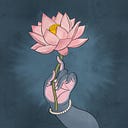The Advent of Śaṅkara
yadā yadā hi dharmasya glānir bhavati bhārata |
abhy-ut-thānam adharmasya tadā ‘tmānaṁ sṛjāmy aham ||
“Whenever there is a fading away of order,
O descendent of Bharata,
And an uprising of disorder —
at that time I propel myself forth (i.e., incarnate in some form).”
(Bhagavadgīta 4.7)
Just as the Supreme Lord incarnated in the world as Kṛṣṇa at a time of internecine conflict, so also He is said to have manifested as Śaṅkara when nāstikas (“those who say ‘it is not”’) were maligning āstikas (“those who say ‘it is’”), who upheld the authority of Veda.
The Madhavīya Śaṅkara Vijayam, the most popular and widely accepted account of Sri Ādi Śaṅkara’s life, describes the advent of Sri Ādi Śaṅkara thus –
“The One sitting under the banyan tree, Lord Dakṣiṇāmūrti (Śiva), the Teacher of the Supreme Truth through the medium of silence, left his place of meditation. He is now moving about in the form of Śaṅkarācārya, imparting his precious knowledge to the world, which has been caught in the boundless dense forests of ignorance and is threatened seriously by the approaching flames of the forest fires of family bondage.”
Śaṅkara was born to Āryāmba and Śivaguru, a Nambudri Brāhmaṇa who belonged to the Vedic branch of Kṛṣṇa Yajur Veda. Śaṅkara’s birthplace was Kalady in Kerala, on the banks of the Poorna river, a few miles from Tiru Shiva Perur (present-day Trichur), which contains the Śiva mound Vrischachala where Āryāmba and Śivaguru prayed and were blessed with the divine child. This event of the birth of Śri Śaṅkara in 788 A.D that marked the beginning of the revival of the Vedic system is described thus in the Madhavīya Śaṅkara Vijayam as follows —
‘Just as the Divine Mother, Pārvati begot Sri Subrahmaṇya, the virtuous Āryāmba begot Śri Śaṅkara on the auspicious Vaiśākha sukla pañchami (the fifth day of the waxing moon during April-May) in the year 788 A.D, when the star attributed to Lord Śiva, Ārudra was in ascendance with the Sun, Saturn, Jupiter, and Mars in exaltation.’
Since it is an impossible task to adequately describe Śaṅkara’s subsequent intellectual supremacy and pāṇdityam, we may rely on the words of Ardhanārīśvara Dīkṣita, the brother of the celebrated literary theorist Rājacūḍāmaṇi Dīkṣita of the court of Tanjavur, and son of Ratnakheṭa Dīkṣita of the court of the Cenji Nāyakas, who wrote in his Ambāstavavyākhyā or Samayamatajīvana of Śaṅkarācārya’s completion of his education, and provides a summation of the young prodigy’s scholastic endeavors:
“At the command of Guru Govindapāda, who was a treasury of virtue,
He first set forth the commentary on the thousand names of Viṣṇu.
Having churned the great ocean of Mantra and Āgama with the churning stick of his intellect,
He extracted the nectar that was the treatises beginning with the Prapañcasāra.
He measured out the Saubhāgyavidyā as well as the ritual handbook, the Subhagodaya:
Two jewel boxes for depositing the meaning of the science of mantra.
To those of lesser eligibility, singularly attached to awareness of brahman with qualities,
He granted favor, bestowing hymns to Hari and Hara.
He granted treatises based on the nondual nature of the self,
As well as hundreds of further hymns, foremost being the Saundaryalaharī.
He drew out the commentary on the Upaniṣads, which, arrayed with recurring floods of virtues,
Made manifest the nondual truth of the Self in the palm of one’s hand dispelling primordial, infinite delusion….
At the age of twelve, having reflected there upon the essence of the scriptures with the Brahminical sages absorbed in meditation,
He effortlessly composed the auspicious commentary, deep and mellifluous, on the collection of sūtras of Śrī Vyāsa, crest jewel among preceptors.”
References:
- Hindu Pluralism: Religion and the Public Sphere in Early Modern South India by Elaine M. Fisher
- SRI SHANKARA DIGVIJAYAM: AN CONCISE ENGLISH TRANSLATION ADAPTED FROM SRI MADHAVIYA SHANKARA DIGVIJAYAM BY SRI VIDYARANYA
__________________________________________
If you find value in my work, I hope you consider becoming a patron or making a one-time contribution to hindu aesthetic via UPI (hindu.aesthetic@okicici).
Hindu Aesthetic requires a lot of time and effort and your support would mean that I can continue bringing you the best possible content. ❤
